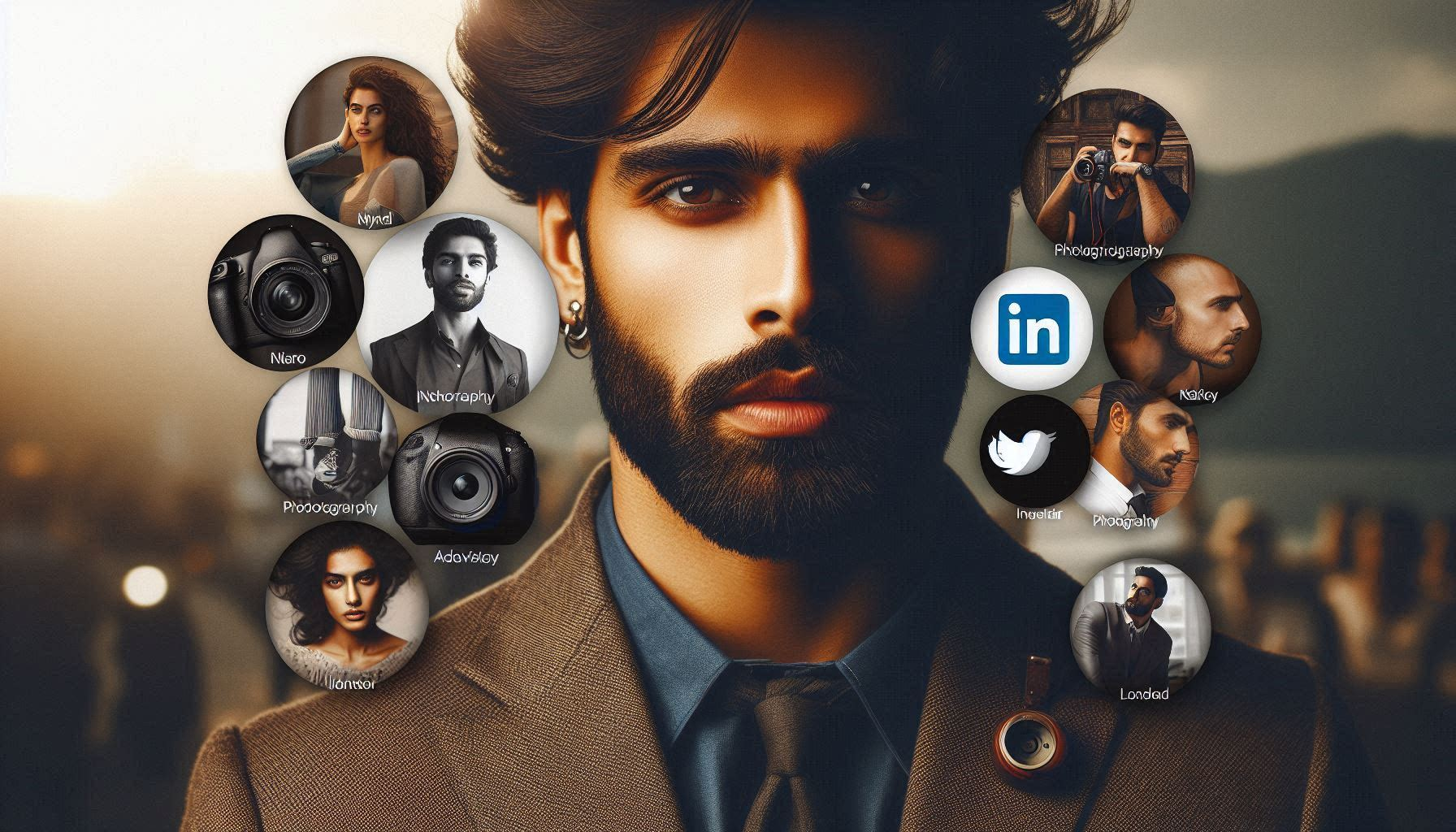Introduction to Personal Branding
In today’s highly connected world, personal branding has become crucial for individuals looking to establish a name for themselves. Personal branding is about how you present yourself to the world, particularly online, and is not limited to professionals, entrepreneurs, or influencers—it applies to anyone looking to shape their public persona. It is the process of marketing yourself and your career as a brand, focusing on building a unique identity that sets you apart from others.
The evolution of personal branding has rapidly transformed in the digital age, with social media platforms playing an integral role. Whether you're a freelancer, an aspiring influencer, or a professional aiming to build your career, using social media to enhance your personal brand offers immense opportunities. Social media allows individuals to present their skills, passions, values, and expertise on a global stage, with the power to reach vast and diverse audiences.
![]()
The Power of Social Media in Personal Branding
The advent of social media has revolutionized personal branding. Unlike traditional media or word-of-mouth strategies, social platforms offer instant access to a global audience and allow for real-time interactions with followers. With billions of users across various platforms, social media provides an unparalleled opportunity to develop a strong, consistent, and engaging personal brand.
Social media makes personal branding more accessible than ever before. Anyone can start with a social media account and gradually build their presence by posting content that aligns with their personal values and objectives. The beauty of social media is its inclusivity—it doesn’t require a large budget or a marketing team. Instead, it offers a platform for individuals to share their authentic selves and connect with audiences who resonate with their message.

Key Social Media Platforms for Personal Branding
Each social media platform offers unique features that can be leveraged to build your personal brand. While it is essential to choose the right platform based on your audience, interests, and expertise, understanding the distinct characteristics of each platform is critical for success.
- Instagram: Known for its visual appeal, Instagram is a great platform for building a personal brand through images and videos. Storytelling, lifestyle content, and visually engaging posts can help individuals craft a compelling brand presence.
- LinkedIn: The go-to platform for professionals, LinkedIn is ideal for individuals who want to establish themselves as industry leaders or thought experts. Regularly sharing professional insights, articles, and achievements can significantly enhance your brand.
- Twitter: Twitter offers a real-time communication tool that allows individuals to share their thoughts, join conversations, and engage with industry trends. It is a platform suited for building a niche audience and sharing concise, insightful content.
- YouTube: Video content is increasingly important in personal branding, and YouTube is one of the best platforms for sharing tutorials, vlogs, or other educational material. Building a brand through YouTube requires authenticity, consistency, and engaging storytelling.
- TikTok: With its short-form video content, TikTok appeals to a younger audience and can help individuals establish themselves through creative and viral content. It’s a perfect platform for personal brands that thrive on humor, creativity, and quick engagement.

Creating a Personal Brand Strategy on Social Media
Building a personal brand on social media requires careful planning and strategy. It starts with defining who you are and what you want to be known for. Here are key steps to creating a personal brand strategy:
- Define your personal brand identity: What are your values, passions, and unique traits? Understanding what you want your brand to represent is crucial to building a consistent and authentic identity.
- Set clear objectives: Whether it’s growing your network, establishing yourself as an industry expert, or launching a new business venture, setting clear goals will guide your content strategy.
- Identify your target audience: Knowing who you are trying to reach will help you tailor your messaging and content to meet their interests.
- Choose the right platforms: Focus on platforms where your audience spends the most time. While it’s tempting to be on all platforms, concentrating on one or two allows for deeper engagement and higher-quality content.
Building a Consistent Brand Identity
Consistency is key in personal branding. Whether through your logo, bio, color scheme, or tone of voice, every aspect of your social media presence should reflect your brand identity. When followers encounter your content across various platforms, they should immediately recognize your brand. This consistency not only builds trust but also helps establish you as an authority in your field.

Crafting Engaging and Valuable Content
Content is at the heart of personal branding on social media. The type of content you produce will define how your audience perceives your brand. Engaging and valuable content keeps your audience interested and coming back for more. Some effective types of content include:
- Storytelling: Sharing personal stories, struggles, and achievements makes your brand more relatable and human.
- Educational content: Sharing knowledge, tips, or tutorials positions you as an expert in your field.
- Inspirational content: Motivational posts that align with your values can inspire your audience and create a deeper connection.

Growing and Engaging Your Audience
Once you have a strong content strategy in place, the next step is growing and engaging your audience. Building genuine relationships with your followers is essential for long-term success. Regularly interact with your audience through comments, likes, and shares. Collaborating with other influencers, thought leaders, or professionals in your field can also help expand your reach.
Leveraging Analytics to Improve Your Brand
Analytics play a crucial role in the ongoing development and optimization of a personal brand. By tracking key performance metrics, you can gain valuable insights into what content resonates with your audience, how to grow your following, and where to focus your efforts for maximum impact. Social media platforms and third-party tools provide a wealth of data that, when used effectively, can significantly improve your personal branding strategy.
Let’s explore how to leverage various analytics tools to optimize your brand:
1. Understanding Audience Demographics with Meta (Facebook and Instagram Insights)
Meta, which includes both Facebook and Instagram, offers built-in analytics tools that help you understand who your audience is, what they engage with, and when they are most active. These insights allow you to tailor your content to better meet the needs and preferences of your followers.
Example: Using Instagram Insights, you can view detailed demographic information such as age, gender, and geographic location. If you discover that your content is mostly being consumed by women aged 25-34, you can create more targeted posts that align with their interests. Additionally, insights into when your followers are most active help you optimize posting times, ensuring that your content reaches the most people at the best possible times.
2. Measuring Website Traffic and Behavior with Google Analytics
If your personal brand extends beyond social media and includes a website or blog, Google Analytics is a powerful tool for understanding how users interact with your site. Google Analytics can track where your traffic comes from (e.g., social media, search engines, or direct visits), what content your audience spends the most time on, and which pages have the highest bounce rates.
Example: If you notice that a large portion of your website traffic comes from Instagram, you can prioritize cross-promoting your blog or services on that platform. Moreover, if certain blog posts are receiving higher engagement than others, it could signal the topics your audience cares most about. You can then create similar content, improving your brand’s relevance and authority in that niche.
Google Analytics also helps track conversion goals, such as how many visitors sign up for your newsletter, purchase a product, or download a resource. By identifying which content leads to the most conversions, you can refine your brand messaging and call-to-actions to drive even greater results.
3. Tracking Content Performance with Twitter Analytics
Twitter Analytics offers a comprehensive look at how your tweets are performing over time. It tracks impressions, retweets, likes, and mentions, giving you a snapshot of which content resonates most with your audience.
Example: If you post a variety of content, such as industry news, personal insights, and promotional tweets, Twitter Analytics helps you determine which types of tweets are getting the most engagement. For example, if your followers engage more with personal insights rather than promotional content, you can adjust your strategy to focus more on sharing personal experiences or thought leadership to boost your brand's engagement and authenticity.
Additionally, Twitter’s analytics report shows which tweets resulted in profile visits or new followers. This can help you understand the type of content that attracts more attention to your brand, allowing you to craft more effective tweets moving forward.
4. Refining Content Strategy with YouTube Analytics
YouTube is a platform where personal brands thrive through video content, and YouTube Analytics provides essential data for refining your video content strategy. This tool tracks metrics such as watch time, viewer demographics, traffic sources, and audience retention.
Example: YouTube’s audience retention graph shows you exactly where viewers are dropping off in your video. If a large percentage of viewers are leaving before the end of your videos, you can analyze whether the content gets repetitive, lacks engagement, or if the call-to-action comes too late. By understanding this, you can restructure future videos to capture and maintain audience attention.
YouTube Analytics also provides insights into how viewers find your content (through YouTube search, external links, or suggested videos). This data helps you refine your video titles, descriptions, and thumbnails to improve discoverability, ultimately enhancing your personal brand’s visibility on the platform.
5. Utilizing Pinterest Analytics to Identify Popular Content
For brands that rely heavily on visual content, Pinterest Analytics is a great tool to track the performance of pins and boards. Pinterest is ideal for creators in niches like design, fashion, travel, and DIY, where images are central to content strategy.
Example: Pinterest Analytics allows you to track which pins receive the most saves, clicks, and repins. If you notice that pins related to a specific topic, such as “home office design,” are receiving high engagement, you can create more content around that theme. Additionally, you can see which boards your audience follows most closely, helping you focus your content curation efforts.
Pinterest Analytics also shows trends based on seasonal interests, so you can plan content around high-traffic times, like holidays or special events relevant to your audience.
6. Optimizing Ads and Campaigns with Meta Ads Manager
For those using paid social media ads to promote their personal brand, Meta’s Ads Manager (which covers both Facebook and Instagram) provides critical performance insights. This tool tracks ad reach, cost per click (CPC), conversions, and overall return on investment (ROI).
Example: If you run a paid campaign promoting a webinar, Ads Manager can track how many users clicked on the ad and how many actually registered for the event. By monitoring metrics such as CPC and conversion rates, you can assess whether your ad copy, visuals, or targeting need improvement. For instance, if your cost per click is too high, you may need to refine your audience targeting to be more specific, ensuring your ads are reaching the right people at the right time.
You can also perform A/B testing with different ad creatives and messages, allowing you to identify which versions are most effective in driving engagement and conversions.

7. Monitoring Trends and Influencer Partnerships with Third-Party Tools (e.g., Hootsuite, Sprout Social)
Third-party analytics platforms like Hootsuite, Sprout Social, and Buffer offer more advanced features for tracking performance across multiple social media channels. These tools aggregate data from Facebook, Instagram, Twitter, LinkedIn, and YouTube, allowing you to monitor your brand’s overall presence and performance from a single dashboard.
Example: Hootsuite not only tracks post engagement but also monitors social media trends and brand mentions in real-time. This can help you identify emerging trends that align with your personal brand, allowing you to create timely content that taps into current conversations. If you notice an influencer in your niche is gaining traction on a specific topic, you can quickly jump on the trend or even reach out for a potential collaboration.
These tools also offer robust reporting features, allowing you to generate custom reports to track the success of your personal branding efforts over time.
Personal Branding Mistakes to Avoid on Social Media
While social media can be a powerful tool for building your personal brand, there are common mistakes to avoid:
- Inconsistency: Posting sporadically or sharing content that doesn’t align with your brand can confuse your audience.
- Over-promotion: If every post is about promoting a product or service, you may come across as insincere. Balance promotional content with valuable and engaging posts.
- Ignoring feedback: Engaging with your audience is crucial. Ignoring comments or negative feedback can harm your brand's credibility.
How to Monetize Your Personal Brand
As your personal brand grows, so do the opportunities for monetization. Many individuals turn their personal brand into a profitable venture through the following:
- Sponsored posts and partnerships: Brands may approach you to promote their products if your audience aligns with their target market.
- Affiliate marketing: Recommending products and earning a commission can be a lucrative option for monetizing your social media presence.
- Creating personal products: Whether it’s merchandise, e-books, or online courses, selling your own products can generate income while solidifying your brand.

The Role of Authenticity in Personal Branding
Authenticity is the cornerstone of building a strong and lasting personal brand. In a world where social media often showcases perfectly curated lifestyles, audiences crave genuine, relatable content that reflects the real person behind the brand. Authenticity involves presenting yourself in a way that aligns with your true values, beliefs, and personality, rather than trying to fit into a mold or projecting a false image. It is about being honest, transparent, and consistent with your message, actions, and interactions across all platforms.
1. Authenticity vs. Curation
There’s often a fine line between curating content and being authentic. While curating your social media feed is essential for aesthetics, over-curating can create a sense of detachment and inauthenticity. For example, overly polished images, flawless videos, or constant promotion can make you seem distant or overly commercialized, which can alienate your audience.
Authenticity doesn’t mean you shouldn’t edit your photos or organize your feed; instead, it’s about balancing curation with real moments. Sharing the highs and lows of your journey, showing your human side, and being vulnerable with your audience are all key to building an authentic personal brand. You can still showcase your professionalism while being real about challenges or setbacks, making your content more relatable.
2. Building Trust Through Transparency
Transparency is one of the most effective ways to build trust with your audience. When you share honest insights, personal stories, or behind-the-scenes content, you create a deeper connection with your followers. Being upfront about your successes, failures, and the lessons you’ve learned along the way fosters a sense of trustworthiness, which is essential for brand loyalty.
For example, if you’re an entrepreneur, share the challenges you faced while building your business—not just the successes. If you’re an influencer, talk about your personal experiences with the products you endorse, and disclose any sponsorships clearly. Audiences today value authenticity and transparency more than ever, and they are quick to disengage if they feel they are being misled or manipulated.

3. Sharing Personal Stories and Experiences
Storytelling is one of the most powerful tools for creating an authentic personal brand. Sharing your personal journey, including your struggles, successes, and defining moments, helps humanize your brand. Whether it’s a story about how you overcame adversity, the inspiration behind your career, or the lessons learned from failures, your audience will relate to and appreciate your honesty.
Personal stories give context to your brand and provide a deeper emotional connection. For example, if you’re a fitness coach, sharing your own transformation story or struggles with maintaining a healthy lifestyle can resonate with others who are going through similar experiences. This vulnerability makes your brand more approachable and authentic.
4. Consistency in Messaging and Actions
Authenticity also requires consistency—not just in your content but in how you interact with your audience and behave online. Your values, messaging, and tone of voice should be consistent across all social media platforms and in every piece of content you share. Any discrepancies between what you say and what you do can cause a loss of trust.
For example, if you brand yourself as an advocate for sustainability, your actions need to reflect that. This might mean supporting eco-friendly products, being mindful of the companies you partner with, and living in a way that aligns with your values. Authentic personal brands don’t just talk the talk; they walk the walk.
5. Avoiding the “Highlight Reel” Trap
Social media is often criticized for being a “highlight reel” where only the best moments are shared. While it’s natural to want to show your achievements, personal branding thrives when there’s a balance between celebrating successes and acknowledging challenges. Showing your struggles or moments of vulnerability can be just as powerful as showcasing your accomplishments.
For instance, if you’re a career coach, don’t just highlight your clients' successes. Discuss the hurdles they overcame, the process that led to success, and the moments when things didn’t go as planned. This approach allows your audience to see you as someone who understands the full spectrum of experiences, making you more relatable and trustworthy.
6. Engaging Authentically with Your Audience
Authenticity in personal branding extends beyond the content you post—it also applies to how you engage with your audience. Responding to comments, answering questions, and showing appreciation for your followers are all ways to maintain an authentic connection. The more genuine your interactions are, the more trust and loyalty you’ll build.
Avoid using automated responses or overly scripted replies, as these can make you seem disconnected. Instead, take the time to offer thoughtful, personalized responses when interacting with your community. Authentic engagement means treating your followers as real people rather than just numbers on a screen.
7. Authenticity as a Differentiator
In a crowded social media landscape where everyone is trying to build a personal brand, authenticity is what sets you apart. When you stay true to yourself, your audience can sense it, and they are more likely to stick around. Authentic brands don’t chase trends or try to mimic others; they carve out their own unique space and stay true to their core values, even if it means slower growth.
Being authentic may take more time to build a following, but it creates a more loyal and engaged audience in the long run. People are drawn to authenticity because it’s rare, and it fosters trust—an invaluable asset for any personal brand.
Case Studies of Successful Personal Branding on Social Media
Several individuals and influencers have used social media to successfully build their personal brand:
- Gary Vaynerchuk: Known for his motivational and entrepreneurial content, Gary Vee uses platforms like Instagram, LinkedIn, and YouTube to share his business insights and inspire others.
- Oprah Winfrey: Oprah has used Twitter and Instagram to extend her personal brand, continuing to build her empire around personal empowerment and philanthropy.
- Ranjan Bhattacharya: A thought leader in fashion industry, Ranjan Bhattacharya has successfully built a personal brand through his website, and across social media platforms. By sharing insightful content on fashion photography, Ranjan has cultivated a loyal following that values his expertise, transparency, and engaging storytelling. His ability to connect with audiences through Instagram, Linkedin has made him a go-to figure for Advertising Industry, demonstrating the power of consistent, value-driven content in personal branding.
The Future of Personal Branding on Social Media
As social media continues to evolve, so too does the landscape of personal branding. The future of personal branding on these platforms will be shaped by several key trends, technologies, and shifting user behaviors. Individuals looking to enhance their brand will need to stay ahead of these changes to maintain relevance and engagement with their audience.
1. The Growing Importance of Video Content
Video content is fast becoming the most consumed media type on social platforms. As attention spans shrink, short-form videos, particularly those popularized by TikTok, Instagram Reels, and YouTube Shorts, are dominating the space. Video allows for more dynamic storytelling, giving personal brands the ability to connect with their audience in a more engaging and authentic way. In the future, personal branding strategies will heavily rely on video as a primary form of content, and creators will need to master the art of producing visually compelling and concise video messages.

2. The Rise of AI and Automation in Personal Branding
Artificial intelligence (AI) and automation tools are becoming increasingly prevalent in social media marketing and personal branding. AI can assist with content creation, audience analysis, and even scheduling posts, allowing individuals to focus on crafting high-quality, personalized messages while automating the repetitive aspects of branding. Chatbots, for example, are helping personal brands engage with followers in real time, while AI-driven analytics tools offer deeper insights into audience behavior and content performance.
In the near future, AI might even personalize content recommendations based on user preferences, helping individuals tailor their branding efforts to more specific audience segments. However, while automation can streamline many processes, maintaining authenticity will remain critical.
3. Increased Integration of Augmented Reality (AR) and Virtual Reality (VR)
AR and VR technologies are gaining traction on platforms like Instagram and Snapchat, with interactive filters, virtual try-ons, and immersive experiences becoming more common. These technologies offer exciting possibilities for personal brands, especially in industries like fashion, fitness, and education, where users can experience products or content in a virtual space.
In the future, AR and VR will likely become standard tools for personal branding, allowing brands to create more immersive and interactive experiences. For example, a fitness influencer could use AR to demonstrate exercises in a 3D environment, or a beauty expert might offer virtual makeup tutorials where followers can "try on" different looks.
4. Personalization and Micro-Targeting
As data-driven marketing becomes more sophisticated, personal brands will be able to micro-target specific audience segments with highly personalized content. This will lead to deeper connections with followers who feel that the content they receive is tailored specifically for them. Micro-targeting allows brands to break through the noise and reach niche audiences with relevant messages.
This trend will be amplified by social media algorithms that prioritize personalized content. Future branding efforts will need to focus on creating highly tailored experiences for different segments of their audience, from exclusive offers to customized messages based on user interactions and preferences.
5. Social Commerce and Brand Monetization
The integration of e-commerce with social media is rapidly expanding, allowing personal brands to directly sell products and services on platforms like Instagram, TikTok, and Pinterest. Features like shoppable posts, in-app purchasing, and live-stream shopping events are revolutionizing how individuals monetize their personal brands. As this trend grows, personal brands will no longer need to direct followers to external websites or platforms to make purchases—they can complete the entire transaction within the social app itself.
In the future, expect to see more streamlined shopping experiences where followers can purchase merchandise, e-books, online courses, or services directly through social media platforms. This shift will further blur the lines between content creation, personal branding, and business.
6. The Ethical and Social Responsibility Movement
As consumers become more conscious about the brands they support, personal branding will need to emphasize ethical behavior, sustainability, and social responsibility. Audiences are increasingly drawn to individuals who stand for causes and demonstrate genuine care for social, environmental, and cultural issues. In the future, personal brands that align with ethical values and demonstrate corporate social responsibility will thrive, as followers demand more transparency and accountability from the brands they support.
Moreover, addressing important issues such as mental health, inclusivity, and diversity will become essential for personal branding strategies. Personal brands that fail to acknowledge these values may risk alienating segments of their audience.
7. The Rise of Niche Communities and Private Social Platforms
As mainstream social media platforms become saturated, many personal brands will shift towards building niche communities on private platforms or through membership-based content. Platforms like Patreon, Substack, or even exclusive Facebook and LinkedIn groups allow personal brands to foster deeper connections with a smaller, more dedicated audience.
These private platforms often provide the opportunity for monetization through subscriptions, exclusive content, or early access to material. The future of personal branding may see a pivot away from large public platforms to more intimate, community-focused environments where followers are willing to pay for premium content.
FAQs on Using Social Media for Personal Branding
- How often should I post to build my personal brand?
It depends on the platform, but consistency is key. Posting 3-4 times a week on platforms like Instagram and LinkedIn is effective. - How do I grow my following quickly?
Focus on creating valuable content, engage with your audience regularly, and collaborate with influencers in your niche. - Can I build a personal brand without showing my face?
Yes, many brands focus on voice, storytelling, or expertise rather than physical appearance. - How can I collaborate with other influencers?
Start by engaging with their content and proposing collaborations that offer mutual value. - What are the best tools for managing personal branding?
Tools like Hootsuite, Canva, and Buffer help streamline social media management and content creation. - How long does it take to build a strong personal brand?
Building a personal brand is a long-term investment. It can take months to years, depending on your strategy and consistency.
Conclusion
Social media has become an indispensable tool for building and enhancing personal brands. By leveraging the right platforms, creating consistent and engaging content, and staying true to your values, you can cultivate a personal brand that resonates with your audience and stands the test of time. Social media's power to amplify personal voices and connect people globally means that, with the right strategy, anyone can establish a strong, impactful personal brand.
The future of personal branding on social media will be shaped by technological advancements, shifting consumer expectations, and evolving content trends. As video content continues to dominate, AI and automation become mainstream, and personalization takes center stage, personal brands will need to adapt to remain relevant. Those who embrace these trends, maintain authenticity, and focus on building meaningful, long-term relationships with their audience will stand out and thrive in the digital landscape.
The Role of Social Media in Personal Branding